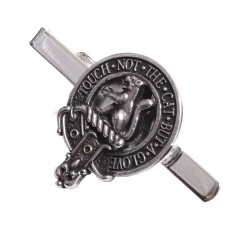

The Hannay crest is a ‘cross crosslet fitchee’ standing on a black crescent.
A cross crosslet fitchee is like a cross with small crosses at the ends of each arm and a pointed bottom arm. This symbolises a devout, steadfast Christianity, the mini crosses suggest the spreading of the message, while the pointed base suggests groundedness or readiness to act. The crescent is often used in Scotland as a mark to denote a second son. Why is the crescent black? That’s unclear.
As discussed in the Arnot article, Sir George MacKenzie of
Rosehaugh’s 1690 Science of Herauldry says ‘the second Son has a Crescent, to
show that he should encrease the Family, by adding to the Estate and Repute of
the Family’ (p.72). It was also a very popular among knightly circles,
sometimes as a reference to crusading culture. Given the cross here, that may
partly lie behind the symbolism here. The Christian cross overcoming the crescent
of the Saracen? Or just a family, descended at some point through a second son,
keen to express their Christian faith.
The shield of the chief of Hannay, the laird of Sorbie, consists of three roebuck’s heads. The Workman Manuscript of 1565/6 seems to show the cross and crescent in the shield (R.R. Stoddart, Scottish Arms being a Collection of Armorial Bearings 1370-1678, p.215) Nisbet seem to suggest the same for the Pont Manuscript of 1624, although contradicts himself later with the roebucks (Nisbet pp.129-130, 328). Either way the crest seems to have originated sometime in the sixteenth century. Given the overt cross, it probably pre-dates the Reformation of 1560.
The soldier and poet, Mr Patrick Hannay, a grandson of
Donald Hannay of Sorbie seems to have introduced the motto. His father being a
younger son of the laird. A depiction of him from 1622 shows motto and both
roebuck shield along with the crest on a wreath.
The motto ‘per ardua ad alta’ is a riff on ‘Per ardua ad astra’ (“through hardship to the stars”). That inspired by classical themes, especially Virgil’s ‘sic itur ad astra’ and Seneca’s n’on est ad astra mollis e terris via’, which emphasise that great achievements require effort. The Hannay version swaps astra (“stars”) for alta (“heights”), keeping the sense of striving upward but losing the poetic connection to the stars. Both express the idea of reaching lofty goals through difficulty.
MKP 17 November 2025

























-240x240w.jpg)


















































